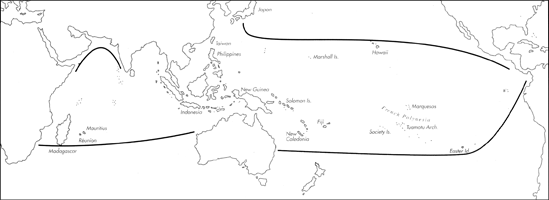
Skip Navigation Links
View access keys for this site.

Range: Entire Indo-Pacific except Red Sea; also W. coast of Central America.
Description: Moderately small to moderately large, moderately solid to solid. Last whorl broadly to broadly ventricosely conical, occasionally slightly pyriform; outline variously convex adapically, straight or slightly concave toward base. Shoulder angulate or subangulate, strongly to obsoletely tuberculate. Spire of low to moderate height, outline straight to convex. Larval shell multispiral. Postnuclear spire whorls strongly to weakly tuberculate. Teleoconch sutural ramps flat to concave, with 2 increasing to 4-5 often weak spiral grooves. Last whorl with widely spaced, smooth or granulose ribs on basal half.
| Shell Morphometry | ||
|---|---|---|
| L | 25-62 mm | |
| RW | 0.22-0.57 g/mm | |
| (L 27-46 mm) | ||
| RD | 0.69-0.78 | |
| PMD | 0.78-0.95 | |
| RSH | 0.06-0.20 | |
Ground colour white, sometimes suffused with pink, mainly in juvenile specimens. Last whorl with 3-4 spiral rows of black blotches between base and subshoulder area; blotches squarish to more or less axially elongate, sometimes branching axially or spirally. Apex often pink. Later sutural ramps with rather regularly set black radial blotches. Aperture white to bluish white, external pattern often visible within.
Periostracum yellowish olive, thin, translucent, smooth.
Dorsum of foot black, with a beige pre-marginal zone along latero-posterior sides and with a red anterior edge. Sole of foot buff, anteriorly edged with pink and bordered with black latero- posteriorly; buff median zone variable in width. Rostrum black, sometimes tipped with a narrow red margin. Tentacles red. Siphon either black with a narrow red tip or rusty red with black dots and lighter on proximal portion (Garrett, 1878; Bergh, 1895; Kohn, 1959a & unpubl. observ.; Chaberman, pers. comm., 1981) (Pl. 74, Fig. 10).
According to SEM studies, radular teeth with a basal spur and a reduced adapical armature of 2 barbs (James, 1980). Troschel (1868), Bergh (1895) and Peile (1939) indicate neither barb nor serration, Troschel and Bergh but neither Peile nor James state that a blade is present.
Habitat and Habits: On intertidal benches and subtidal coral reef platforms, to about 3 m; abundant in both types of habitat, with peak density of population nearer to the shore or halfway across intertidal habitats. On patches of sand bound by algal turf, in sand-filled depressions and crevices, on limestone benches with algal turf, and among or beneath dead coral (Kohn, 1959b, 1966b, 1968b, 1971; Kohn & Orians, 1962; Kohn & Nybakken, 1975; Leviten & Kohn, 1980; Reichelt & Kohn, 1985; Tirard, pers. comm., 1989; Grosch, pers. comm., 1989). C. ebraeus feeds on eunicid and nereid polychaetes; diet composition varies with habitat and locality (Kohn, 1959b; Kohn & Orians, 1962; Kohn & Nybakken, 1975; Leviten & Kohn, 1980; Reichelt & Kohn, 1985). Egg capsules measure 7-10 x 6-10 mm. Each capsule contains 1,500 -3,000 eggs 170-180 ┬Ám in diameter, predicting a minimum pelagic period of about 25-26 days (Risbec, 1932; Ostergaard, 1950; Kohn, 1961b; Perron, 1981b; Perron & Kohn, 1985).
Discussion: C. ebraeus and C. chaldaeus are very closely related species; for comparison, see the DISCUSSION of the latter species. According to Bergh (1895), C. ebraeus and C. judaeus do not differ in external and internal morphology, except for the armature of the radular teeth (C. judaeus: tooth with an adapical barb opposing a sharp blade; serration present). However, Bergh's figures are somewhat contradictory, and as noted above Bergh, Peile and James do not agree with one another. In addition, Bergh's information on C. judaeus refers to a single specimen, and the separation of C. judaeus from C. ebraeus cannot be retained. Walls (1979) assigned C. judaeus to C. chaldaeus, but this contradicts Bergh's original description.

C. ebraeus Range Map
This section contains verbatim reproductions of the accounts of 316 species of Conus from the Indo-Pacific region, from Manual of the Living Conidae, by R÷ckel, Korn and Kohn (1995). They are reproduced with the kind permission of the present publisher, Conchbooks.
All plates and figures referred to in the text are also in R÷ckel, Korn & Kohn, 1995. Manual of the Living Conidae Vol. 1: Indo-Pacific Region.
The range maps have been modified so that each species account has it own map, rather than one map that showed the ranges of several species in the original work. This was necessary because each species account is on a separate page on the website and not confined to the order of accounts in the book.
Return to framed version (returns to search page)